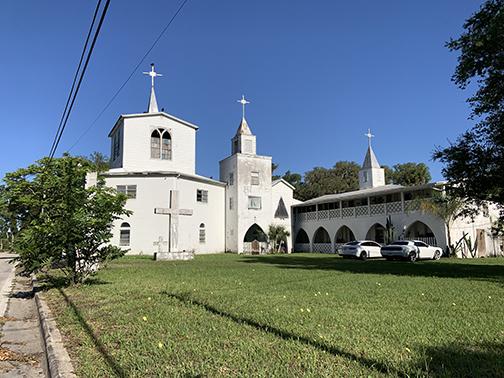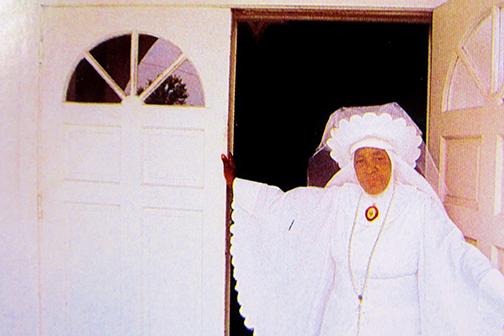Newsweek captured the Ark's Mother Essie Mae in 1986
By Al Krombach
Wally McNamee was following a quiet road westward out of Crescent City, cruising past orange groves and modest homes, when a startling sight made him stretch for his brake pedal and his camera bag.
Nudging the roadside was a wide vision in white, gleaming in the morning sunshine like some snow-blanketed mini-Everest.
“Something you don’t see every day,” he allowed later.
The day was May 2, 1986.
A veteran Newsweek magazine photographer, McNamee was one of 200 professional photojournalists recruited to chronicle that specific day across the United States for a book to be titled, appropriately, “A Day in the Life of America.”
Seven photographers were assigned to Florida at sites including Miami Beach, Cape Canaveral and Disney World. One well-known lensman drew Crescent City and environs in order to capture a “Real Florida” vibe. For reasons best left unexplored, he growled not just no, but … anyway, a hasty swap was arranged. Wally McNamee came to South Putnam.
McNamee, Newsweek’s award-winning Washington Bureau photographer, was equally at home in the rice paddies of Vietnam or on the plush carpets of the Oval Office. He quickly established himself in Crescent City, spending the better part of two days scouting photo possibilities with the help of local escorts before the actual day-of.
The Junction Road sight that brought McNamee up short was the unique realization of one person’s dreams, a 40-foot-high, 100-room structure composed of equal parts mother church and soup-soap-and-hope mission. It bore the weighty name Mount Zion, The Overcoming Body of Christ, The True Bride Church. Its founder, architect and resident saint was Mother Essie Mae McDonald.
Upon inquiry, McNamee was invited by an acolyte to return that afternoon in order to give Mother Essie Mae time to compose herself properly for a photo shoot.
Giving her life to God
Records are scarce, but Essie Mae McDonald was born, possibly in Crescent City, in 1910 or 1911. She was living in New York City in the 1940s when, having miraculously recovered from a severe illness, she resolved to give her life to God. After some years preaching the Gospel in Los Angeles, she came to Crescent City to establish her church on land bequeathed by her mother. She began to raise her first simple chapel on June 1, 1960. Incorporated into the present-day structure, it’s still there, forming the footings of a building as unconventional as Mother Essie Mae herself.
Proclaiming herself a Bride of Christ, she dressed in a white gown with a voluminous head covering and veil. She wore a cross and Bleeding Heart around her neck. She carried a tall, white shepherd’s crook with a crucifix and dove on its top. She did not wear shoes or a coat.
Mother Essie Mae drew many to her church for reasons other than spiritual. They came for food and clothing. They came for shelter. They came for healing. She monitored the lives of local children whose needs came to her attention. She found them warm coats, signed them up for school and got them their vaccinations. And all the while, she grew that big white church. She called it the Ark.
As inspiration struck her, she’d round up blocks and boards and added another room, another steeple, another cross.
“She didn’t have anything on paper. It all came from up here,” one-time resident Maxine Kerley told a reporter in 2006, tapping her head.
In a pre-internet age, supporting donations materialized from around the country.
McNamee wasn’t admitted to the building itself. If he had been, he would have found four kitchens and dining rooms, four worship rooms, an “upper room” gathering space where the furnishings were entirely white, multiple lecterns with Bibles and candlesticks, a prayer tower, men’s and women’s quarters, and other spaces, some colorfully painted, some plain, many decorated in motifs of six-pointed stars and hearts.
Mother Essie Mae’s enthusiasms didn’t wane until time caught up with her. She died on March 13, 2005, aged 94.
“Love, peace and joy in the world” were the words she lived by.
Making the book
Along with his portrait of Mother Essie Mae, McNamee shot his way through more than 30 rolls of Kodachrome, capturing South Putnam Countians at work and play from burly crabbers on Lake George to wildflower gatherers in Satsuma.
The editors of “A Day in the Life” were choosy. Only about 130 of the 200 photographers found any of their work reproduced in the five-pound, coffee-table volume. McNamee, and Mother Essie Mae, made the final cut.
“Mother McDonald had a special quality that comes right through the photos,” McNamee said when contacted following the book’s publication. “I wasn’t surprised when she was picked for ‘The Day in the Life’ book. It was a special experience meeting her.”
Today, Mount Zion, The Overcoming Body of Christ, The True Bride Church rests in a state of genteel decrepitude, Crescent City’s faded concrete-and-timber Taj Mahal. Its enduring sturdiness reflects one woman’s strength, determination and profound devotion to her mission as she saw it.
Copyright 2021 by Palatka Daily News - all rights reserved.


